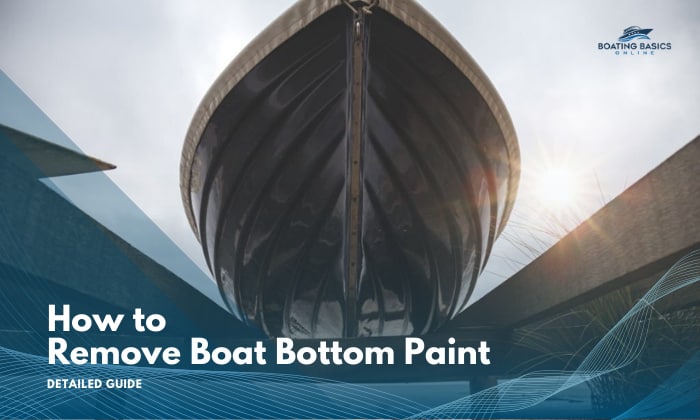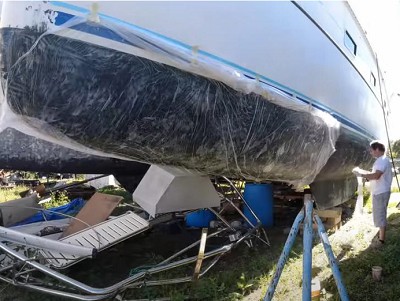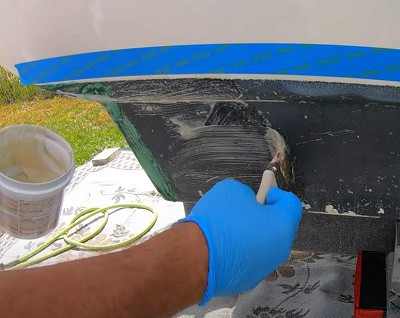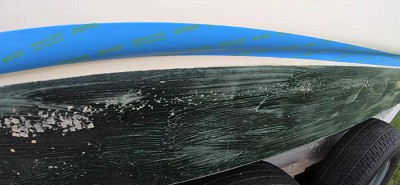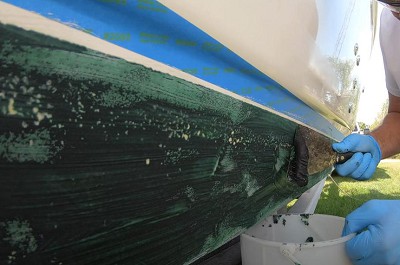Whether you’re prepping for a repaint, doing repairs, or just want the old bottom paint on your vessel gone, this guide on how to remove boat bottom paint will teach you the most foolproof ways possible.
Either of these methods always saves me time and effort. Also, who wants to do a lot of sanding and inhale all that paint dust?
I’ve tried every bottom paint removal technique and have arrived at these two, and I encourage you to give either one a try for the superior results I’m talking about.
Table of Contents
Ways to Remove Boat Bottom Paint
I use chemical strippers and do so in two ways based on the materials I have available.
- Plastic + stripper
- Scraper + stripper
Like plenty of boaters out there, I was sanding bottom paint mainly in the past, and all it did was lengthen the time to get results I wanted.
I reckoned since most of my peers have moved on to primarily stripping boat paint, I also needed to freshen up my approach to removing bottom paint.
So, yes, I’m a fan of stripping more than sanding. I removed paint from fiberglass boat and from gelcoat using chemical strippers, and the amount of time it saved me just isn’t comparable.
Note before starting:
We’re relying mostly on chemicals, so we need to be smart with the locations we’re going to do this thing. You have to be mindful of the environmental impact of chemical strippers. Incidentally, I implore you to go non-toxic as much as possible.
It’s highly recommended to do your bottom paint removal and other preparation steps in a well-ventilated location where you can easily contain the possible toxic wastewater that will be created. Don’t do it in a place where the wastewater will find its way into sewers and open water.
Steps for Plastic + Stripper Method
What you need to prepare:
- Stripping gel like Citristrip or any chemical stripper
- Plastic covering sheets
- Sander
- Paintbrush, roller, or paint sprayer
- Painter’s tape (optional)
- Pain scraper
- PPEs (gloves and safety goggles)
1. Paint the stripper onto the hull
Put on your PPEs first. Read the instructions on how to apply the stripper you’re using. For CitriStrip, the instructions say I need to apply a thick coat and wait for an entire day at most for the effect to play out.
That’s what I’ve done for most of my projects, and I get the results I want every time. Use any of the three painting tools you like. Depending on how adept you are at using it and the vessel’s size, expect this to take only a few hours or more.
2. As you paint, lay the plastic sheet covers on the areas you’ve finished
You can either apply the paint on the surface or underneath the side of the sheets that will be sticking to the old bottom paint. Just make sure that the plastic will stay in place over the areas where you applied the stripper. This is where using the tape comes in.
I recommend you put the tape on the bottom paint’s upper edges, but feel free to find a better setup.
3. Wait an entire day then peel the plastic back, then start scraping
If you haven’t got the time, wait for at least 3 to 5 hours before removing the sheets. Afterward, you can start scraping the treated paint off. You should be able to knock off big chunks of paint in no time.
Sand off any stubborn residue that the stripper didn’t take off. The advantage of sanding post-stripper application is that the old coat will likely fall right off with minimal effort and produce less dust.
How long you should do this step depends on how thick the layers of paint are or your purpose for removing the old coat.
- If you’re just doing a new bottom job, then you don’t need to remove all the chunks, just the bad ones.
- A copper coat will typically require you to do a full removal.
Guide for Scraper Only + Stripper Technique
What you need to prepare:
- Chemical stripper (I like to use Total Strip paint remover or Back to Nature’s Aqua-Strip)
- PPEs
- Pain scraper
- Bucket for catching paint strips
- Pressure washer (optional)
- Paintbrush
- Sander with 2000-grit sandpaper
1. Put on your PPEs then start applying the stripper
Read the instructions on how to apply the bottom paint stripper. What I like about this method is that it skips the plastic sheeting and saves me more time. I just need to dab the stripper on the entire length and width covered by the old bottom paint, and it will do the work for me.
Just apply the coats evenly. As long as the stripper makes contact with the old paint, it should start doing its magic.
2. Wait for an hour or an entire day
If I use TotalBoat’s Total Strip, I tend to follow the manufacturer’s instructions to wait 24 hours. With the Aqua-Strip, an hour will suffice. That should help you make your choice for the stripper to use if you have time to burn or not.
On the whole, both give me consistently amazing results in all the years I’ve used them.
3. Start removing the old paint, then sand as needed
Once the stripper has settled and you’ve waited the recommended time, pick up your scraper and bucket then begin removing the original antifouling paint coat. Peel away bottom paint and take off as many layers as you can, so you won’t have to sand as much later on.
Even so, you’ll probably want a smoother, cleaner finish, so don’t skip sanding. I use a 2,000-grit mostly for that nice, smooth finish. You can finish with the pressure washer if you like, but I often make do without it.
Wipe down the sanded surface to finish.
Things to Consider to Protect the Environment
Part of the reason why I prefer the first method is that it’s not toxic to me, but can I say the same for its environment-friendliness? Yes, especially if you know your alternatives.
- Choose a safe location to do your project, such as the one I mentioned above.
- For one, you can always replace any toxic paint remover with a non-toxic one. Try looking at soy-based and citrus-based products like Citri-Strip.
- Do more sanding if you really don’t mind the effort and time required. The less you rely on toxic strippers, the better.
- Many swear by soda blasting boat bottoms, but it will require special equipment, starting with the soda blaster and air compressor.
Most owners who remove paint from aluminum boat report that sandblasting (a mix of soda blasting and sanding) works best for them. The same goes for their steel-hulled counterparts.
Cost to Remove Boat Bottom Paint
Expect a removal service to charge $75 per foot at most to restore gelcoat for private vessels. Much like any service, bottom paint removal cost varies per company. Just two years ago, I was charged $50 per foot, and I don’t expect that to have changed at present.
What Happens if You Don’t Remove the Boat Bottom Paint?
If you refrain from removing old bottom paint from a boat, it will inevitably start affecting its performance. Damage to the gelcoat may slow it down and dampen the hull’s performance-boosting effect.
Also, can you live with the thought that that old paint is most probably flaking off from time to time? Just think of the environmental toll that would exact.
Helpful Tips/FAQs
Can a pressure washer remove bottom paint?
Yes, oftentimes, you don’t have to worry about it damaging the gel coat. However, there is always a chance that it might, so be careful when going down this route.
Another downside is that some coats are too stubborn for a pressure washer to handle. It may be a good option if you want a quick way to get the looser chunks off quickly, but you’ll likely still need to sand, wipe, and scrape off layers if you’re going for complete removal of the old paint.
How often should you remove boat bottom paint?
If you’re doing a bottom paint repaint, you’ll likely need to remove the old coat at least once a year or two. If you decide to do this, you don’t need to take off and sand entire layers, only the ones that have gone bad, then paint on a fresh coat.
Conclusion
Based on my experience and the guide I’ve come up with, you definitely need to know how to remove boat bottom paint optimally. There are way too many steps that you can forgo, such as sanding for hours and days, using toxic chemical strippers, and doing the removal job in a risky place.
Do your best to stick to the methods (stripper + plastic or scraper), and I guarantee that you’ll save yourself from needless effort and produce excellent results that even the pros will envy. Never forget to put your safety and environment’s first and foremost when doing this yourself, though.

“My intention from the first day establishing Boating Basics Online is to provide as much help as possible for boaters who want to experience a first safe and convenient trip. So feel free to join us and share your beautiful journeys to the sea!”

